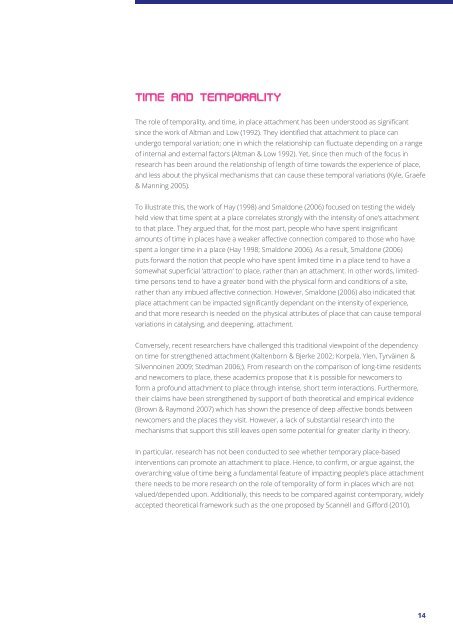Exploring the Role of 'Visual Catalysts' on Influencing People's Attraction and Use of Place
Undergraduate Thesis // Keegan Lovell // Bachelor of Landscape Architecure // UNSW 2016
Undergraduate Thesis // Keegan Lovell // Bachelor of Landscape Architecure // UNSW 2016
Create successful ePaper yourself
Turn your PDF publications into a flip-book with our unique Google optimized e-Paper software.
TIME AND TEMPORALITY<br />
The role <str<strong>on</strong>g>of</str<strong>on</strong>g> temporality, <strong>and</strong> time, in place attachment has been understood as significant<br />
since <str<strong>on</strong>g>the</str<strong>on</strong>g> work <str<strong>on</strong>g>of</str<strong>on</strong>g> Altman <strong>and</strong> Low (1992). They identified that attachment to place can<br />
undergo temporal variati<strong>on</strong>; <strong>on</strong>e in which <str<strong>on</strong>g>the</str<strong>on</strong>g> relati<strong>on</strong>ship can fluctuate depending <strong>on</strong> a range<br />
<str<strong>on</strong>g>of</str<strong>on</strong>g> internal <strong>and</strong> external factors (Altman & Low 1992). Yet, since <str<strong>on</strong>g>the</str<strong>on</strong>g>n much <str<strong>on</strong>g>of</str<strong>on</strong>g> <str<strong>on</strong>g>the</str<strong>on</strong>g> focus in<br />
research has been around <str<strong>on</strong>g>the</str<strong>on</strong>g> relati<strong>on</strong>ship <str<strong>on</strong>g>of</str<strong>on</strong>g> length <str<strong>on</strong>g>of</str<strong>on</strong>g> time towards <str<strong>on</strong>g>the</str<strong>on</strong>g> experience <str<strong>on</strong>g>of</str<strong>on</strong>g> place,<br />
<strong>and</strong> less about <str<strong>on</strong>g>the</str<strong>on</strong>g> physical mechanisms that can cause <str<strong>on</strong>g>the</str<strong>on</strong>g>se temporal variati<strong>on</strong>s (Kyle, Graefe<br />
& Manning 2005).<br />
To illustrate this, <str<strong>on</strong>g>the</str<strong>on</strong>g> work <str<strong>on</strong>g>of</str<strong>on</strong>g> Hay (1998) <strong>and</strong> Smald<strong>on</strong>e (2006) focused <strong>on</strong> testing <str<strong>on</strong>g>the</str<strong>on</strong>g> widely<br />
held view that time spent at a place correlates str<strong>on</strong>gly with <str<strong>on</strong>g>the</str<strong>on</strong>g> intensity <str<strong>on</strong>g>of</str<strong>on</strong>g> <strong>on</strong>e’s attachment<br />
to that place. They argued that, for <str<strong>on</strong>g>the</str<strong>on</strong>g> most part, people who have spent insignificant<br />
amounts <str<strong>on</strong>g>of</str<strong>on</strong>g> time in places have a weaker affective c<strong>on</strong>necti<strong>on</strong> compared to those who have<br />
spent a l<strong>on</strong>ger time in a place (Hay 1998; Smald<strong>on</strong>e 2006). As a result, Smald<strong>on</strong>e (2006)<br />
puts forward <str<strong>on</strong>g>the</str<strong>on</strong>g> noti<strong>on</strong> that people who have spent limited time in a place tend to have a<br />
somewhat superficial ‘attracti<strong>on</strong>’ to place, ra<str<strong>on</strong>g>the</str<strong>on</strong>g>r than an attachment. In o<str<strong>on</strong>g>the</str<strong>on</strong>g>r words, limitedtime<br />
pers<strong>on</strong>s tend to have a greater b<strong>on</strong>d with <str<strong>on</strong>g>the</str<strong>on</strong>g> physical form <strong>and</strong> c<strong>on</strong>diti<strong>on</strong>s <str<strong>on</strong>g>of</str<strong>on</strong>g> a site,<br />
ra<str<strong>on</strong>g>the</str<strong>on</strong>g>r than any imbued affective c<strong>on</strong>necti<strong>on</strong>. However, Smald<strong>on</strong>e (2006) also indicated that<br />
place attachment can be impacted significantly dependant <strong>on</strong> <str<strong>on</strong>g>the</str<strong>on</strong>g> intensity <str<strong>on</strong>g>of</str<strong>on</strong>g> experience,<br />
<strong>and</strong> that more research is needed <strong>on</strong> <str<strong>on</strong>g>the</str<strong>on</strong>g> physical attributes <str<strong>on</strong>g>of</str<strong>on</strong>g> place that can cause temporal<br />
variati<strong>on</strong>s in catalysing, <strong>and</strong> deepening, attachment.<br />
C<strong>on</strong>versely, recent researchers have challenged this traditi<strong>on</strong>al viewpoint <str<strong>on</strong>g>of</str<strong>on</strong>g> <str<strong>on</strong>g>the</str<strong>on</strong>g> dependency<br />
<strong>on</strong> time for streng<str<strong>on</strong>g>the</str<strong>on</strong>g>ned attachment (Kaltenborn & Bjerke 2002; Korpela, Ylen, Tyrväinen &<br />
Silvennoinen 2009; Stedman 2006;). From research <strong>on</strong> <str<strong>on</strong>g>the</str<strong>on</strong>g> comparis<strong>on</strong> <str<strong>on</strong>g>of</str<strong>on</strong>g> l<strong>on</strong>g-time residents<br />
<strong>and</strong> newcomers to place, <str<strong>on</strong>g>the</str<strong>on</strong>g>se academics propose that it is possible for newcomers to<br />
form a pr<str<strong>on</strong>g>of</str<strong>on</strong>g>ound attachment to place through intense, short term interacti<strong>on</strong>s. Fur<str<strong>on</strong>g>the</str<strong>on</strong>g>rmore,<br />
<str<strong>on</strong>g>the</str<strong>on</strong>g>ir claims have been streng<str<strong>on</strong>g>the</str<strong>on</strong>g>ned by support <str<strong>on</strong>g>of</str<strong>on</strong>g> both <str<strong>on</strong>g>the</str<strong>on</strong>g>oretical <strong>and</strong> empirical evidence<br />
(Brown & Raym<strong>on</strong>d 2007) which has shown <str<strong>on</strong>g>the</str<strong>on</strong>g> presence <str<strong>on</strong>g>of</str<strong>on</strong>g> deep affective b<strong>on</strong>ds between<br />
newcomers <strong>and</strong> <str<strong>on</strong>g>the</str<strong>on</strong>g> places <str<strong>on</strong>g>the</str<strong>on</strong>g>y visit. However, a lack <str<strong>on</strong>g>of</str<strong>on</strong>g> substantial research into <str<strong>on</strong>g>the</str<strong>on</strong>g><br />
mechanisms that support this still leaves open some potential for greater clarity in <str<strong>on</strong>g>the</str<strong>on</strong>g>ory.<br />
In particular, research has not been c<strong>on</strong>ducted to see whe<str<strong>on</strong>g>the</str<strong>on</strong>g>r temporary place-based<br />
interventi<strong>on</strong>s can promote an attachment to place. Hence, to c<strong>on</strong>firm, or argue against, <str<strong>on</strong>g>the</str<strong>on</strong>g><br />
overarching value <str<strong>on</strong>g>of</str<strong>on</strong>g> time being a fundamental feature <str<strong>on</strong>g>of</str<strong>on</strong>g> impacting people’s place attachment<br />
<str<strong>on</strong>g>the</str<strong>on</strong>g>re needs to be more research <strong>on</strong> <str<strong>on</strong>g>the</str<strong>on</strong>g> role <str<strong>on</strong>g>of</str<strong>on</strong>g> temporality <str<strong>on</strong>g>of</str<strong>on</strong>g> form in places which are not<br />
valued/depended up<strong>on</strong>. Additi<strong>on</strong>ally, this needs to be compared against c<strong>on</strong>temporary, widely<br />
accepted <str<strong>on</strong>g>the</str<strong>on</strong>g>oretical framework such as <str<strong>on</strong>g>the</str<strong>on</strong>g> <strong>on</strong>e proposed by Scannell <strong>and</strong> Gifford (2010).<br />
14


